A eulogy for Nancy Reagan — and for Reaganism
SIMI VALLEY, Calif. — After leaving the Republican debate stage Thursday night, Donald Trump, the tinsel-haired GOP frontrunner, took to cable news to describe the event as “elegant” — again and again (and again). But Nancy Reagan never had to tout her own elegance. She lived it instead.
On Friday, the former first lady, who died on March 6 at age 94, was laid to rest beside her husband here, at the Ronald Reagan Presidential Library, as rain dampened the patchwork hills, shrouded the Santa Susana Mountains in the distance and pattered upon the large white tent where politicians, celebrities, former heads of state and a dwindling circle of old friends came to pay their respects. Wayne Newton, Anjelica Huston, Tina Sinatra and Joan Rivers’ daughter, Melissa, evoked the Reagans’ Hollywood years; Michelle Obama, Hillary Clinton, Caroline Kennedy and former President George W. Bush represented their reign in Washington, D.C.
Lucid to the end, and demanding as ever, Mrs. Reagan spent her final months planning every last detail of the service, from the readings (Proverbs 31:10:30 — “When one finds a worthy wife, her value is far beyond pearls”) to the music (“Ave Maria,” “Amazing Grace,” “The Battle Hymn of the Republic”) to the letter from “her Ronnie” to be read by former Canadian Prime Minister Brian Mulroney (“There could be no life for me without you”).

The casket carrying Nancy Reagan’s body leaves the funeral service at the Ronald Reagan Presidential Library in Simi Valley, Calif. (Photo: Jae C. Hong/AP)
Slideshow: Saying goodbye to Nancy Reagan >>>
Standing before Mrs. Reagan’s burnished mahogany casket, heaped with white roses and peonies, the former first lady’s children, and a few of her most famous friends, took to the podium, one after another, to reflect upon her life. They mentioned the usual things: how devoted she was to her husband, how she shielded him from those who wished him ill, how lonely she felt after he died. But there was another note they kept sounding, almost without realizing it; they kept contrasting the way she conducted herself with the way politics is conducted today.
“Unlike too many people these days, [Nancy] didn’t harden differences into definitions,” said ABC News anchor Diane Sawyer as she recalled their lunches together — lunches at which Mrs. Reagan would eat “microscopic amounts of food” and Sawyer would “hide [her] bread and butter under the table” so as not to “offend.”
“She knew … how to stand her ground, and once it had been resolved, to move on,” said NBC News anchor Tom Brokaw as he recalled the various times he had, in fact, offended the former first lady — first by questioning whether President Reagan’s “poor-boy narrative was overblown” and later by forgetting to acknowledge her presence at Gerald Ford’s funeral.
“Most of my mother’s buddies are gone now,” added her son, Ron Reagan. “She’s among the last of her cohort, the old gang, her generation.”
None of this year’s Republican presidential candidates, it’s worth noting, were in attendance.
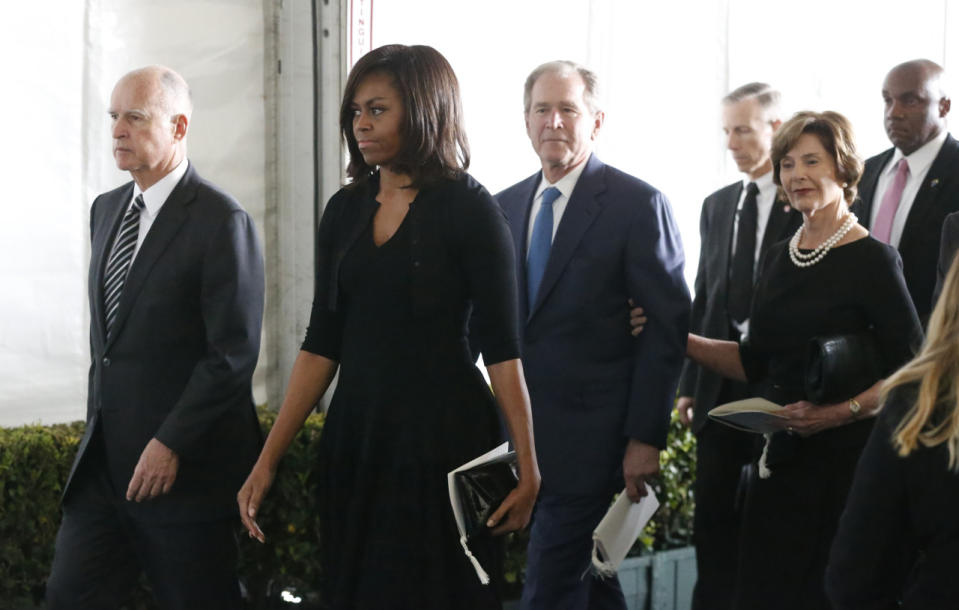
From left, California Gov. Jerry Brown, first lady Michelle Obama, former President George W. Bush and former first lady Laura Bush leave after the funeral. (Photo: Reuters)
All funerals are about loss. But Mrs. Reagan’s memorial felt like it was about more than the end of her life, or even the end of the elegance she embodied. It felt like the end of a political era. The services Friday threw into sharp relief how the Republican Party — the party her husband reinvigorated and redefined over more than a quarter century of leadership — is consuming itself in perhaps the most surreal presidential primary in U.S. history, which seems to be coming down to a contest between an opportunistic reality television star and a senator roundly despised by virtually the entire Republican caucus.
Trump is the most obvious apostate, his style the most obvious apostasy. Where the Reagans conveyed a kind of nostalgic glamour — she in her Adolfo suits, he in his Stetson hat, both of them writing mushy love letters back and forth — Trump, with his Chardonnay-colored comb-over, conveys only the nouveau-riche glitz of marble, gilt and his own name in the largest possible letters. At his primary-night press conferences, Trump hawks Trump steaks, Trump wine, and Trump magazine, as if campaigning to become QVC-pitchman-in-chief. He has no use for Reaganesque decorum or restraint; he slings more insults in a single speech than the Reagans did in their entire lifetimes.
Trump’s politics are a departure as well. In the debates, he likes to mention that President Reagan was also a former Democrat — a fellow convert to the Republican cause. But after Reagan became a conservative in his 40s, he remained a conservative; he sounded much the same in 1984, running for reelection, as he had in 1964, delivering his pivotal “Time for Choosing” speech. Trump has been a member of the Democratic Party and the Reform Party; he has quit and rejoined the GOP twice since first registering as a Republican in 1987; his views are all over the map and often the opposite of what they were a few years before.
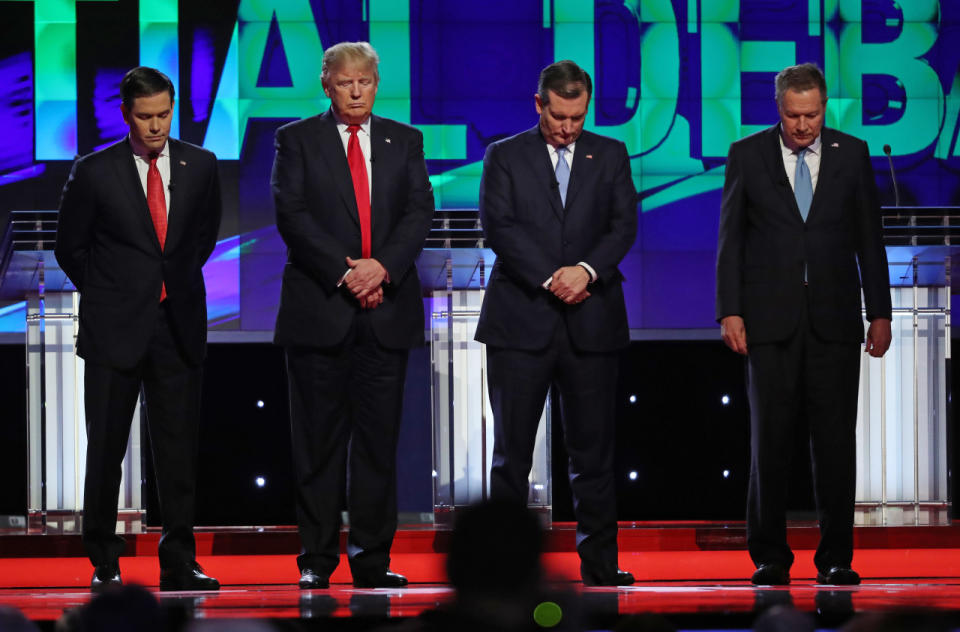
Presidential candidates Marco Rubio, Donald Trump, Ted Cruz and John Kasich observe a moment of silence in memory of Nancy Reagan at the start of the Republican candidates’ debate in Miami on Thursday. (Photo: Carlo Allegri/Reuters)
Being Republican has long meant being like Reagan — or at least saying you’re like Reagan. Republican Dinesh D’Souza neatly captured the conservative conventional wisdom when he suggested that the right “simply need[s] to ask in every situation that arises: what would Reagan have done?” If Trump is nominated — if Republican voters select as their standard bearer someone who wants to impose trade tariffs on China, who mocks and demonizes Mexicans and who supported single-payer health care as recently as last September — it will mark the demise of Reaganism as the GOP’s primary organizing principle. Trump is about Trump. He is a party of one.
Ted Cruz, on the other hand, takes pains to cast himself as Reagan’s heir. On the stump he promises to “reassemble that old Reagan coalition.” He often frames the GOP primary as a “time for choosing.” And he even compares 2016 to 1980, with Barack Obama as Jimmy Carter and (you guessed it) Ted Cruz as the Gipper.
But what Cruz actually represents, with his tea-party purity tests and vintage 1980s-era policy positions, isn’t the second coming of Saint Ronnie but rather the apotheosis of a certain strain of willful Republican misremembering. In the years since Reagan left the White House, a vocal contingent of Republicans has sought to enforce current party orthodoxy — cut taxes at all costs; limit government spending (except on defense); let Jerry Falwell’s Bible be your guide — by insisting that Reagan was its source. But while these concepts often shaped Reagan’s campaign rhetoric, they didn’t define how he governed once in office. As a result, the Reagan that Republicans now revere — a mythical founder figure who always cut taxes, always rattled his saber and always consulted Jesus — barely resembles the more pragmatic Reagan who actually ran the country.
“Reagan is a difficult icon for Republicans,” biographer Lou Cannon once told this reporter. “He was an achiever and, by and large, a successful president. But he wasn’t a successful president in the way that the Republican hero-worshippers describe him. Of course ideology was important to Reagan. But he was a success because of, and in spite of, ideology. He cared more about getting stuff done.”
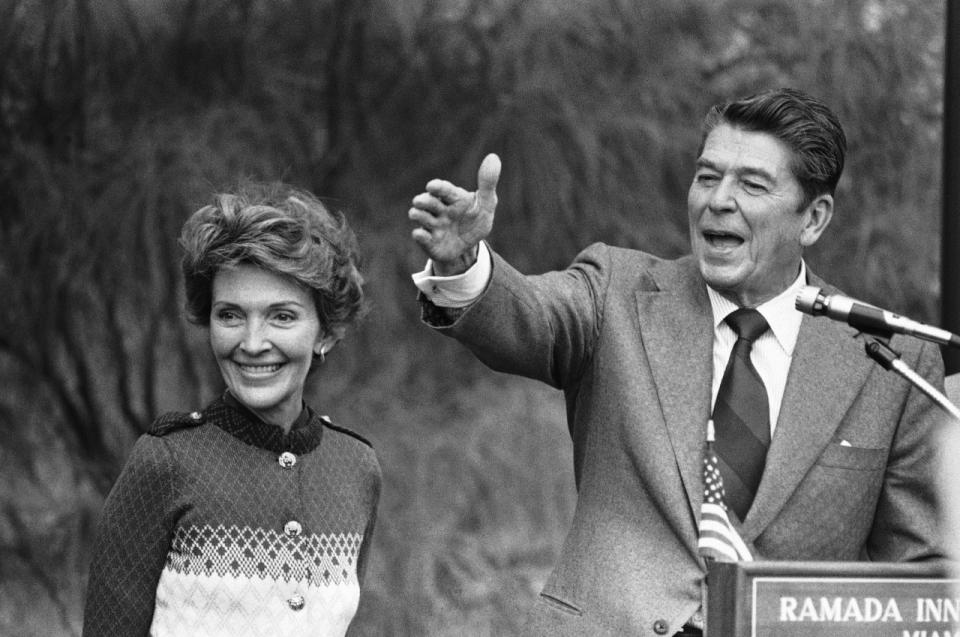
Ronald Reagan, with Nancy, campaigns in Miami in 1975 after announcing that he was a candidate for the presidency. (Photo: Bill Hudson/AP)
Slideshow: Nancy Reagan – A look back >>>
Reagan’s pragmatism was pervasive. While he was personally opposed to things like homosexuality and abortion, he almost never let his religious views dominate his policies. (HIV/AIDS was a prominent exception.) As Reagan speechwriter Peter Robinson once noted in the Wall Street Journal, “Reagan dismissed ‘the illegal alien fuss’” and “again and again declared that a basic, even radical, openness to immigration represents a defining aspect of our national identity.” When it came to taxation, there were two Reagans: the pre-1982 version, who did more than any other president to lighten America’s tax burden, and his post-1982 incarnation, who was willing (if not always happy) to make up gaps in the government’s revenue stream by raising rates. And despite his hawkish rhetoric, Reagan was a believer in arms control and only rarely exercised military force against America’s enemies.
Worshipping Reagan’s myth, as Cruz does — and pretending that his campaign promises and rhetoric represent his entire legacy — is almost as un-Reaganesque as dismissing him entirely, as Trump does. Instead, a true Reaganite would study how the Gipper actually governed, then modernize his approach for today’s world.
He would also study Nancy Reagan.
Most famously, Mrs. Reagan pushed her husband to update his views on guns. Even after he was shot and nearly killed by an assassin in 1981, President Reagan maintained that access to firearms was not “where the problem lies.” But Mrs. Reagan began to have her doubts.
“After what I saw in that hospital, I’m not sure I agree with him,” she wrote in her 1989 memoir, “My Turn.”
Eventually, President Reagan came around. “With the right to bear arms comes a great responsibility to use caution and common sense on handgun purchases,” Reagan said in a March 1991 speech. He went on to support the Brady Bill, which mandated federal background checks and was named for Reagan’s press secretary, Jim Brady, who was also shot (and more seriously injured) during the assassination attempt. When critics argued that background checks were ineffective because criminals would simply cross state lines to buy guns, the former president fought back. “All the more reason to have a federal law that fills the gaps,” he wrote in 1991. “This level of violence must be stopped.”
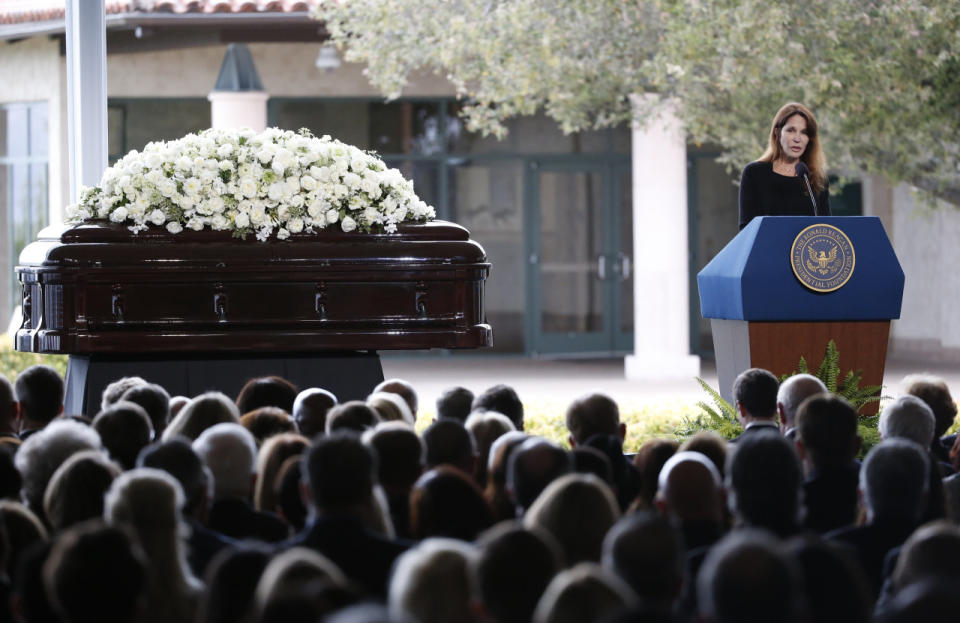
Patti Davis, daughter of Ronald and Nancy Reagan, speaks at her mother’s funeral. (Photo: Lucy Nicholson/Reuters)
For Mrs. Reagan, this sort of pragmatism was a crucial part of her husband’s legacy, and she carried on in his spirit after he died — even when it put her at odds with her fellow Republicans. On Friday her daughter, Patti Davis, told another, less familiar story about her mother’s insistence that a conservative could change with the times — and still be a conservative.
“On one occasion, I am quite certain that she was channeling my father,” Davis said. “I had gone up to her house and found her very busy making phone calls to elected officials, trying to gain their support for stem-cell legislation — something she was quite passionate about. She ended one phone call and gave me a somber look.
“‘Well,’ she said, in a calm tone, sounding much more like my father than herself. ‘Karl Rove is dogging my phone calls. Everyone I call, he calls right after and tries to get them to oppose stem-cell legislation.’
“‘Right after?’ I asked. ‘Are you sure your phone isn’t bugged?’
“‘No, I had the Secret Service check on that.’
“‘You must be furious,’ I told her, puzzled by the fact that she didn’t seem furious at all. She shook her head no, and her entire demeanor was not only calm — it was practically Zen.”
Davis paused for a moment to joke that “even people who never met my mother will know that the word ‘Zen’ has never been applied to Nancy Reagan.” The crowd laughed. Then Davis returned to her story and recalled what her mother told her next.
“‘There’s no time to get upset,’ she said. ‘There’s work to be done. I can’t get distracted. I have to keep moving forward.’”
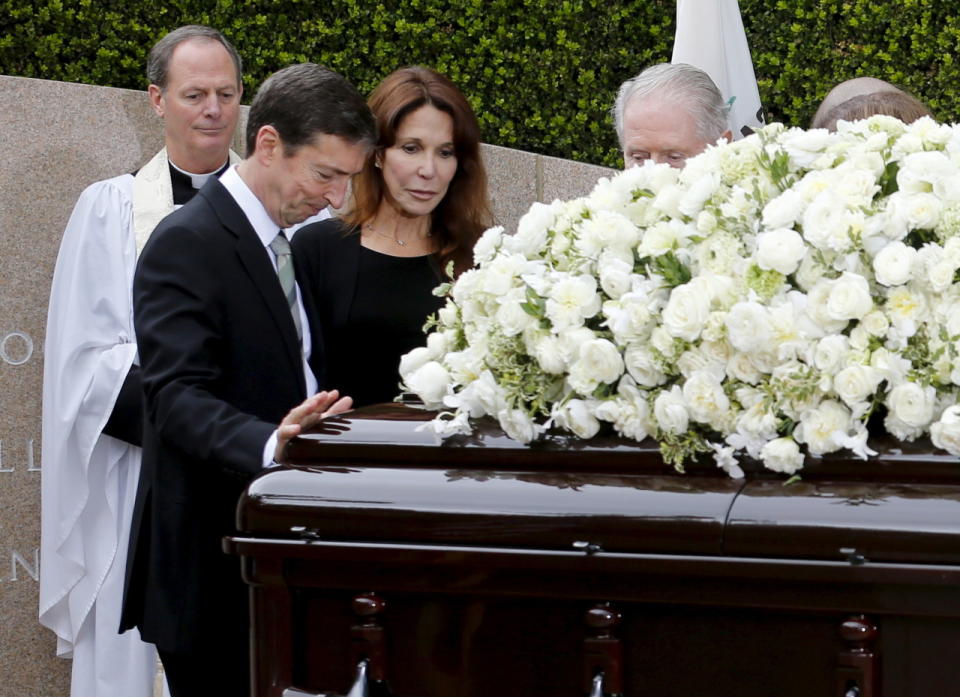
Ron Reagan and his sister, Patti Davis, pay their respects to their mother during the funeral. (Photo: Mike Blake/Reuters)
Cover tile photo: Jae C. Hong/AP


